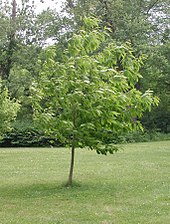Conservation efforts in North America[edit]
Experimental trials by the The American Chestnut Foundation at Tower Hill Botanic Garden in Massachusetts
There are approximately 2,500 chestnut trees growing on 60 acres (24 ha) near West Salem, Wisconsin, which is the world's largest remaining stand of American chestnut. These trees are the descendants of those planted by Martin Hicks, an early settler in the area. In the late 1800s, Hicks planted fewer than a dozen chestnuts. Planted outside the natural range of American chestnut, these trees escaped the initial wave of infection by chestnut blight, but in 1987 scientists found blight also in this stand. There is a program to bring American chestnut back to the Eastern forest funded by the American Chestnut Foundation, Wisconsin Department of Natural Resources, USDA Forest Service, West Virginia University, Michigan State University, and Cornell University.[39]
Removing blighted trees to control the disease was first attempted when the blight was discovered, but this proved to be an ineffective solution. Scientists then set out to introduce a hyperparasitic hypovirus into the chestnut blight fungus. The trees infected with virus-treated fungus responded immediately and began to heal over their cankers. However, the virus was so efficient at attenuating fungal growth that it prevented the spreading of the virus from an infected fungus growing on one tree to that growing on another tree. Only the virus-treated trees recovered. Scientific opinion regarding the future of the stand varies.[39]
- Home
- Forum
- Journals
- Gallery
- What's New?
- Todays Posts
- 2,000 Miler Listing
-
Odd & Ends
- About WhiteBlaze/Tools
- About WhiteBlaze
- WhiteBlaze user agreement
- WhiteBlaze logo progression
- WhiteBlaze screen savers
- Purchase a banner spot
- Quick reference
- Usercp
- Subscribed Threads
- Members List
- Calendar
- Mark all forums read








 Reply With Quote
Reply With Quote